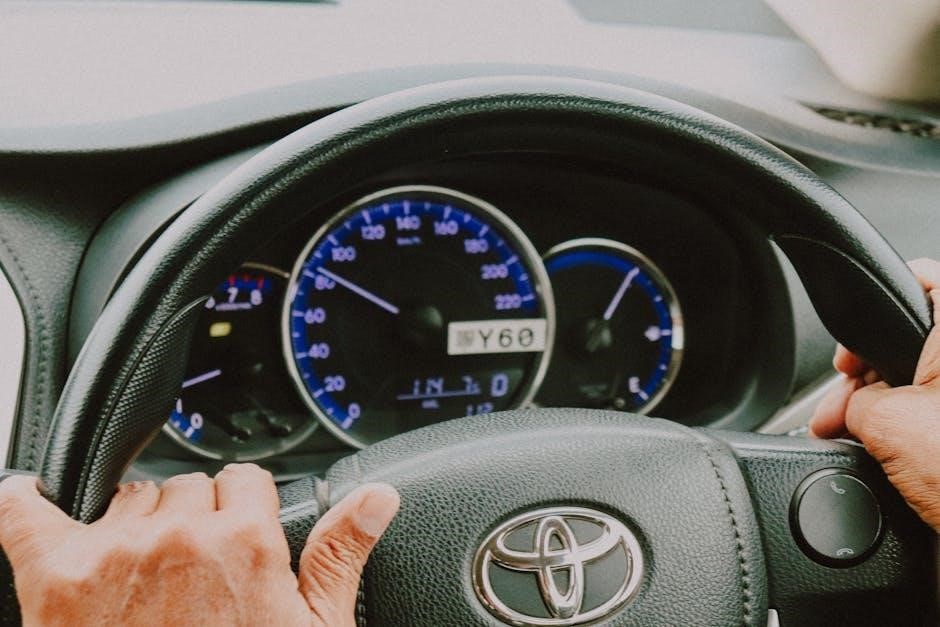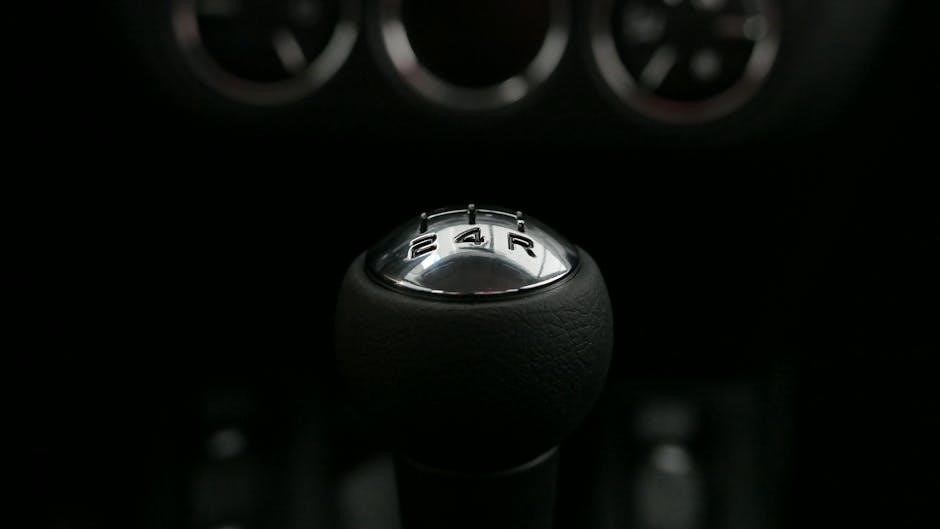The South Dakota Driver’s Manual, published by the Department of Public Safety, is a comprehensive guide covering traffic laws, road signs, and safe driving practices․ It serves as an essential resource for new and experienced drivers, helping them understand their responsibilities and prepare for knowledge tests․
Overview of the South Dakota Driver’s Manual
The South Dakota Driver’s Manual is a detailed guide designed to help drivers understand the state’s traffic laws, road signs, and driving regulations․ Published by the South Dakota Department of Public Safety, it covers essential topics such as speed limits, right-of-way rules, and safe driving practices․ The manual also addresses special conditions like driving in adverse weather and sharing the road with motorcycles, trucks, and bicyclists․ It serves as a key resource for both new and experienced drivers, providing a comprehensive overview of the rules of the road․ Additionally, it includes information on obtaining different types of licenses, such as regular, commercial, and motorcycle licenses, ensuring all drivers are well-informed and prepared for safe and legal driving․
Importance of the Driver’s Manual for Safe Driving
The South Dakota Driver’s Manual is a crucial resource for promoting safe driving practices across the state․ It provides detailed information on traffic laws, road signs, and defensive driving techniques, helping drivers of all experience levels operate vehicles safely․ By understanding the manual, drivers can reduce the risk of accidents and ensure compliance with state regulations․ It also serves as a key tool for preparing for the knowledge test, ensuring new drivers are well-informed before getting behind the wheel․ The manual emphasizes the importance of responsible driving, highlighting tips for sharing the road with other vehicles and handling emergency situations․ Regular review of the manual fosters a culture of safety and continuous learning, empowering drivers to maintain their skills and stay aware of updated traffic laws․

Eligibility Requirements for a South Dakota Driver’s License
Eligibility for a South Dakota driver’s license requires meeting age, residency, and documentation standards, along with passing vision and medical evaluations to ensure qualified and safe drivers․
Age Requirements for Different License Types
In South Dakota, the minimum age to apply for a restricted driver’s license is 14 years old, while a full driver’s license is available at 16․ Learner’s permits are issued to teens as young as 14 with parental consent․ Those under 18 must complete a driver’s education course or log 50 hours of supervised driving, including 10 at night․ For a commercial driver’s license (CDL), applicants must be at least 21 years old․ A motorcycle license is available at 14 years old for a restricted permit and 16 years old for a full license․ These age requirements ensure young drivers gain experience and safety skills before obtaining full driving privileges․
Residency and Documentation Requirements
To obtain a driver’s license in South Dakota, applicants must provide proof of residency and identity․ Acceptable documents for identity include a birth certificate, passport, or Social Security card, while utility bills or lease agreements are used to verify residency․ Non-citizens must provide valid immigration documents․ All documents must be original or certified copies, with translations notarized if necessary․ This ensures compliance with state and federal regulations, verifying eligibility for a South Dakota driver’s license․ Proper documentation is essential to avoid delays in processing applications․
Medical and Vision Standards
In South Dakota, drivers must meet specific medical and vision standards to ensure road safety․ A vision test is required, assessing visual acuity and peripheral vision․ Applicants must have a visual acuity of at least 20/40 in both eyes, with corrective lenses permitted if needed․ If one eye has worse than 20/70 vision, a restricted license may be issued․ Additionally, a medical evaluation is required for certain conditions that could impair driving ability․ The Department of Public Safety may request a medical report to assess fitness to drive․ These standards aim to ensure all drivers can operate vehicles safely and responsibly․ Failure to meet these requirements may result in license restrictions or denial․

Application Process for a South Dakota Driver’s License
The process involves gathering documents, visiting a licensing office, completing forms, passing vision and knowledge tests, paying fees, and receiving a temporary license․
Gathering Required Documents
To apply for a South Dakota driver’s license, applicants must gather specific documents to verify identity, residency, and legal status․ These include a birth certificate, Social Security card, or passport for identity, and a utility bill or lease agreement for residency․ Non-citizens must provide valid immigration documents․ All documents must be original or certified copies, as photocopies are not accepted․ Translations of documents must be notarized if necessary․ Ensuring all documents meet the state’s requirements is crucial to avoid delays in processing the application․ Proper documentation is the first step in the licensing process, helping establish eligibility and compliance with state and federal regulations․
Visiting a Driver Licensing Office
Visiting a driver licensing office is a critical step in obtaining a South Dakota driver’s license․ Applicants are encouraged to make an appointment to reduce wait times and ensure a smoother process․ At the office, you will complete the application form, submit required documents, and take necessary tests․ Be prepared to provide proof of identity, residency, and legal status, as well as pass a vision test․ Knowledge tests are also administered on-site․ Office staff will guide you through the process, ensuring all steps are completed accurately․ Proper preparation and arriving early can help make your visit efficient․ Remember to bring all required documents and fees to avoid delays․ This in-person visit is essential to finalize your application and progress toward obtaining your license․

Completing the Application Form
Completing the application form is a straightforward step in the licensing process; Applicants must provide accurate and complete information, including personal details, residency status, and legal documentation․ The form will ask for your full name, date of birth, and Social Security number, as well as information about your residency in South Dakota․ It is crucial to ensure all details are correct to avoid delays or complications․ Once filled out, the form will be reviewed by licensing office staff․ Applicants are advised to double-check their entries for accuracy before submitting․ This step ensures that all necessary information is on file, facilitating the rest of the application process․ Proper completion of the form is essential for a smooth and efficient experience․ Be prepared to provide all required details when filling out the application․
Vision Test Requirements
The vision test is a mandatory step in obtaining a South Dakota driver’s license, ensuring applicants meet minimum visual standards for safe driving․ The test assesses visual acuity and peripheral vision, with a requirement of 20/40 in both eyes․ If one eye has vision worse than 20/70, a restricted license may be issued․ Applicants must pass the test with or without corrective lenses, such as glasses or contacts․ Those who wear corrective lenses should bring them to the test․ Failure to meet the standards may result in a medical evaluation or restricted driving privileges․ The test is straightforward but critical for determining if an applicant can safely operate a vehicle․ Meeting these vision requirements is essential for obtaining a driver’s license in South Dakota․
Knowledge Test Overview
The South Dakota knowledge test is a multiple-choice exam assessing understanding of traffic laws, road signs, and safe driving practices․ Based on the official driver’s manual, it covers topics such as speed limits, right-of-way rules, and defensive driving techniques․ Applicants must answer a minimum number of questions correctly to pass․ The test is available in multiple languages and is required for obtaining a learner’s permit․ Preparation is key, with the driver’s manual serving as the primary study resource․ Additional tools, such as online practice tests, can help applicants gauge their readiness․ Passing the knowledge test is a critical step toward obtaining a driver’s license and demonstrates a foundational understanding of safe driving principles and legal responsibilities on South Dakota roads․
Paying the Applicable Fees
Paying the applicable fees is a necessary step in the South Dakota driver’s license application process․ The fees vary depending on the type of license, such as regular, commercial, or motorcycle․ Applicants can pay using accepted methods like cash, credit cards, checks, or money orders․ It is important to verify the exact fee amount and payment options with the local driver licensing office beforehand, as these may vary by location․ Ensuring payment is made correctly and promptly helps avoid delays in processing the application․ This step is crucial for obtaining a temporary license while the permanent one is being issued․ Keeping track of payment receipts is also recommended for record-keeping purposes․
Receiving a Temporary License
Upon completing the application process and paying the required fees, applicants in South Dakota receive a temporary driver’s license․ This temporary license serves as proof of legal driving privileges while the permanent license is being processed and mailed․ The document is typically valid for a specified period, allowing applicants to drive legally during the waiting time․ It is important to ensure all personal details are accurate on the temporary license, as any errors may delay the issuance of the permanent one․ Applicants should keep the temporary license with them at all times while driving and be aware of its expiration date․ Once the permanent license is ready, it will be mailed to the address provided during the application process;

Types of Driver’s Licenses in South Dakota
South Dakota offers various driver’s licenses, including regular, commercial, and motorcycle licenses, each tailored to specific driving needs and requirements for safe and legal operation․
Regular Driver’s License
A regular driver’s license in South Dakota allows individuals to operate non-commercial vehicles, such as cars and trucks, for personal use․ To obtain this license, applicants must meet age requirements, pass vision, knowledge, and driving tests, and provide required documentation․ The license is valid for a specific period and must be renewed․ It ensures drivers understand traffic laws and safe driving practices, promoting road safety for all motorists․ This license is essential for personal transportation and is issued to drivers who meet all eligibility criteria, including residency and medical standards․ It is the most common type of license and serves as the foundation for legal driving privileges in South Dakota․
Commercial Driver’s License (CDL)
A Commercial Driver’s License (CDL) in South Dakota is required to operate commercial vehicles, such as semi-trucks, buses, and construction equipment․ Eligibility includes being at least 21 years old, passing a medical exam, and providing proof of residency․ Applicants must complete a knowledge test and skills test, including a pre-trip inspection and driving assessment․ CDLs are classified into Class A, B, and C, with endorsements for specialized vehicles like hazmat or passenger transport․ This license ensures professional drivers meet rigorous safety and operational standards, enabling them to handle large or complex vehicles safely and efficiently․ Obtaining a CDL involves a thorough process to guarantee adherence to federal and state regulations, ensuring public safety on South Dakota’s roads․
Motorcycle License

To obtain a motorcycle license in South Dakota, applicants must meet specific requirements․ A restricted permit is available at 14 years old, while a full license is issued at 16․ Applicants are required to pass a written knowledge test, a vision test, and a motorcycle skills test․ Completion of a motorcycle safety course, such as those offered by the Motorcycle Safety Foundation, is highly recommended to ensure safe riding practices․ The license allows operation of motorcycles and requires adherence to specific safety guidelines outlined in the driver’s manual․ Proper training and education are emphasized to promote responsible and safe motorcycle operation on South Dakota roads․ This ensures that motorcyclists are well-prepared to handle the unique challenges of riding safely․

The South Dakota Knowledge Test
The South Dakota Knowledge Test evaluates understanding of traffic laws, road signs, and safe driving practices․ It is a multiple-choice exam based on the official driver’s manual, ensuring applicants are prepared for the responsibilities of driving in the state․ The test is administered in various languages and is a mandatory step toward obtaining a driver’s license, regardless of age or license type․ Passing the test demonstrates a clear comprehension of road safety and legal requirements, which are essential for all drivers to maintain safe road conditions․ Proper preparation through studying the manual and taking practice tests is highly recommended to achieve success․
Format of the Knowledge Test
The South Dakota Knowledge Test is a multiple-choice exam designed to assess a candidate’s understanding of traffic laws, road signs, and safe driving practices․ The test is based entirely on the South Dakota Driver’s Manual and covers essential topics such as speed limits, right-of-way rules, and special driving conditions․ Questions are presented in a clear and straightforward format, ensuring clarity for all applicants․ The test is typically administered on a computer or in written form, depending on the location․
To pass, applicants must answer a minimum number of questions correctly, demonstrating their knowledge of road safety and legal requirements․ The test is available in multiple languages to accommodate diverse applicants, ensuring equal access for all․ Proper preparation through studying the manual is crucial for success, as the test serves as a critical step toward obtaining a driver’s license․
Preparing for the Knowledge Test
Preparing for the South Dakota Knowledge Test begins with thoroughly studying the state’s Driver’s Manual, which covers essential topics like traffic laws, road signs, and safe driving practices․ The manual is available in both English and Spanish and can be downloaded as a PDF for convenient study․ Additionally, online practice tests are available to help assess readiness and identify areas needing review․ Focus on understanding road signs, right-of-way rules, and special driving conditions․ It’s important to take notes and review any challenging sections multiple times․ Practicing with sample questions can also build confidence and familiarity with the test format․ By dedicating time to study and review, applicants can ensure they are well-prepared for the exam․
Key Topics Covered in the Test
The South Dakota Knowledge Test covers essential topics to ensure drivers understand safe practices and legal requirements․ Key areas include road signs, traffic laws, right-of-way rules, and safe driving techniques․ The test also addresses speed limits, special driving conditions like adverse weather, and sharing the road with other vehicles․ Understanding traffic signals, pedestrian rights, and emergency procedures is crucial․ Additionally, the test includes questions about vehicle safety checks and the proper handling of hazardous situations․ These topics are designed to assess a driver’s ability to operate a vehicle safely and legally in South Dakota․ By focusing on these areas, the test ensures motorists are well-prepared to navigate the state’s roads responsibly․

Vision and Medical Standards for Drivers
South Dakota requires drivers to meet specific vision and medical standards․ Visual acuity of 20/40 is typically mandated, with restrictions possible for impaired vision․ Medical evaluations ensure safety․
In South Dakota, a vision test is mandatory for obtaining a driver’s license․ The test evaluates visual acuity and peripheral vision to ensure safe driving ability․ Applicants must meet a minimum visual acuity standard of 20/40 in both eyes, with or without corrective lenses․ If one eye has vision worse than 20/70, a restricted license may be issued․ Those wearing glasses or contacts must bring them to the test․ The vision test is a straightforward process but failing to meet the requirements may result in a restricted license or the need for a medical evaluation․ This ensures that all drivers can operate vehicles safely and responsibly on South Dakota roads․
Medical Evaluation for Driving Eligibility
In South Dakota, a medical evaluation may be required to determine driving eligibility, especially for individuals with health conditions that could impact their ability to drive safely․ Drivers must undergo a medical assessment if they have conditions such as epilepsy, diabetes, or vision impairments that could pose a risk on the road․ The evaluation is conducted by a licensed medical professional and assesses physical and mental fitness for driving․ Commercial drivers, in particular, must meet rigorous medical standards to ensure public safety․ If the evaluation identifies significant health issues, driving privileges may be restricted or denied until the condition is managed․ This process helps maintain road safety by ensuring all drivers are physically and mentally capable of operating vehicles responsibly․

Safe Driving Practices in South Dakota
South Dakota promotes road safety through responsible driving practices, emphasizing adherence to traffic laws, proper vehicle maintenance, and emergency preparedness to ensure the well-being of all road users․
Defensive Driving Techniques
Defensive driving is a proactive approach to road safety, emphasizing anticipation and avoidance of potential hazards․ Key techniques include maintaining a safe following distance, scanning the road ahead, and staying alert to other drivers’ actions․ This method helps minimize risks and prevent accidents․ Additionally, defensive drivers adapt their speed according to road conditions, such as weather or traffic congestion․ Being courteous and aware of surroundings, including pedestrians and cyclists, further enhances safety․ Regular vehicle maintenance, such as ensuring proper tire pressure and functioning brakes, also supports defensive driving practices․ By combining these strategies, drivers can significantly reduce the likelihood of collisions and contribute to a safer roadway environment for everyone; Consistent practice of these techniques fosters responsible and vigilant driving habits․

Sharing the Road with Other Vehicles
Sharing the road with other vehicles requires mutual respect and safe practices to ensure harmony and safety for all users․ Drivers must be aware of and yield to pedestrians, bicycles, and motorcycles, as these vulnerable road users require extra caution․ When encountering large trucks or buses, maintain a safe distance to account for their longer stopping distances and blind spots․ Always check mirrors and blind spots before changing lanes or turning․ Use signals to communicate intentions clearly to other drivers․ Be patient and courteous, avoiding aggressive behaviors that could increase the risk of accidents․ By understanding and respecting the needs of all road users, drivers can contribute to a safer and more efficient transportation system․ This approach fosters a collaborative environment where everyone can share the road safely and responsibly․
Emergency Procedures and Safety Tips
Emergency procedures and safety tips are crucial for handling unexpected situations on the road․ Stay calm and assess the situation to make informed decisions․ If involved in an accident, move to a safe location, turn on hazard lights, and call emergency services if necessary․ Keep an emergency kit in your vehicle, including items like a first-aid kit, flashlight, and reflective triangles․ Always wear a seatbelt and ensure passengers do the same․ If your vehicle breaks down, pull over to a safe area and use warning devices to alert other drivers․ Avoid sudden movements and follow proper procedures for jump-starting or changing a tire․ Stay informed about weather conditions and adjust driving habits accordingly․ Regular vehicle maintenance can also prevent emergencies and ensure safety on the road․ Preparedness and awareness are key to managing unexpected situations effectively and safely․
The South Dakota Driver’s Manual emphasizes the importance of continuous learning and driving responsibility to ensure public safety and legal compliance on the road․
Continuous Learning and Driving Responsibility
Continuous learning and driving responsibility are cornerstones of safe and lawful driving in South Dakota․ The Driver’s Manual underscores the importance of staying informed about traffic laws, road signs, and safety practices․ As road conditions and regulations evolve, drivers must remain vigilant and adapt their skills accordingly․ Regular review of the manual ensures awareness of updates and promotes responsible driving habits․ Defensive driving techniques, sharing the road with other vehicles, and understanding emergency procedures are key areas emphasized for long-term safety․ By fostering a culture of continuous learning, South Dakota aims to empower drivers with the knowledge and skills needed to maintain a safe and responsible driving environment for all road users․
